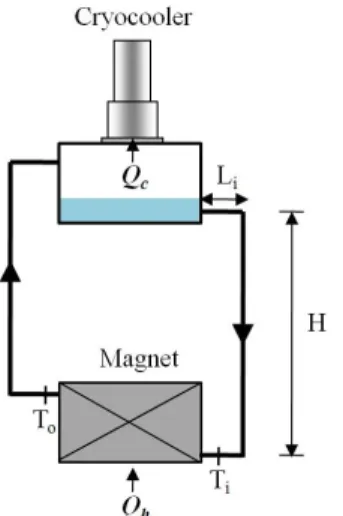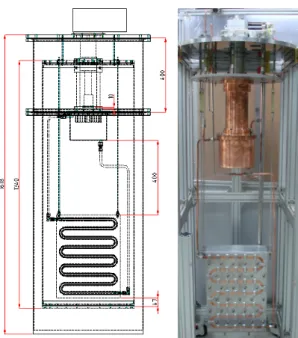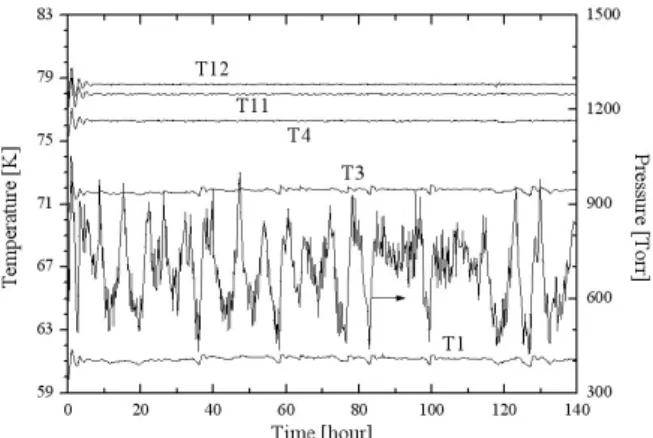Progress in Superconductivity and Cryogenics
Vol.15, No.3, (2013), pp.49~52 http://dx.doi.org/10.9714/psac.2013.15.3.049
```
1. INTRODUCTION
The discovery of the high temperature superconductor (HTS) opened new opportunities in the design of several power utility applications, mainly because of the easy and economical cooling with liquid nitrogen at considerably higher temperature around 77 K. The HTS was initially described as liquid nitrogen superconductor, because liquid nitrogen seemed to be a technically suitable and inexpensive heat transfer fluid. The cooling method using the combination of a cryogenic fluid with emerging a cryocooler is an attractive way for cooling of superconducting magnets. A natural circulation loop is a compact and efficient cooling option for superconducting magnet system since no circulating pump is required. In a natural circulation loop, the circulating fluid removes heat from a heat source and transports it to a heat sink and it is the result of the buoyancy force caused by the thermally induced density difference in a body force field [1].
There have been a number of previous experimental and theoretical studies on the natural circulation loop [2-6].
Most of them have mainly reported the fundamental thermo-fluid problem using water as a working fluid. In spite of its significance a few specific attention, however, has been paid to the cryogenic fluid natural circulation for large scale superconducting applications as far as the author aware. No circulation pump is necessary, so the natural circulation cooling systems have obvious advantage in mechanical reliability over the forced circulation systems. However, the heat transfer capability of natural circulation loop may be limited, depending on the relative
magnitude of buoyancy force against flow resistance of cryogenic liquid in the loop.
In order to confirm the feasibility of the design for superconducting cyclotron cooling, the experiment of the natural circulation loop has been designed and fabricated.
The primary purpose of the experiment, therefore, is the simulation of the thermal environment as closely as possible to the prototype of the superconducting cyclotron.
In this paper, we describe the natural circulation loop experiment and present the results of natural circulation using liquid nitrogen by a cryocooler. In addition, the effects of the magnitude of a heat flux and operating temperature on the heat transfer characteristics of the natural circulation are investigated.
2. NATURAL CIRCULATION LOOP
Fig. 1 shows the schematic of the natural circulation system to simulate the cryogenic cooling system for the cyclotron superconducting magnet. A cryocooler is located at the top to re-condense cryogenic vapor coming from the superconducting magnet. The vapor is condensed and flows back to the superconducting magnet, therefore it is a closed loop system. The circulating liquid removes heat from a superconducting magnet and transports it to the cryocooler or heat sink, resulting from the buoyancy force caused by the thermally induced density difference in a body force field. Generally the heat sink is located above the heat source to enhance the circulate rate.
A number of experimental and theoretical studies have been performed on the natural circulation, suggesting useful correlations in a standard form [3,5,7].
Experimental study on natural circulation using liquid nitrogen for superconducting applications
Yeon Suk Choi*
Korea Basic Science Institute, Daejeon, Korea
(Received 6 September 2013; revised or reviewed 24 September 2013; accepted 25 September 2013)
Abstract
An experiment to investigate the natural circulation of a cryogen has been performed. The study is motivated mainly by our recent development of cryogenic cooling system for prototype superconducting cyclotron without any circulating pump. In the natural circulation loop system, a cooling channel is attached on the outer surface of the aluminium block and the liquid nitrogen passes through inside of the channel to cool the block indirectly. A cryocooler as a heat sink is located at the top to re-condense cryogenic vapor coming from the aluminium block in which electrical heater is installed as a heat source. The main dimensions are determined using the relevant analysis and the natural circulation loop is successfully fabricated. The temperature distributions in the loop are measured during initial cool-down process and in steady state, from which the modified Grashof numbers are calculated and compared with the existing correlation estimated with one-dimensional analysis for steady state flow.
Keywords : Natural circulation, two-phase flow, cryogenic cooling, superconducting magnet
* Corresponding author: ychoi@kbsi.re.kr
Experimental study on natural circulation using liquid nitrogen for superconducting applications
=
= L
Gr D D fn
m m,
Re 4 µ π
(1)
where Re is Reynolds number composed of the mass flow rate, viscosity of fluid and the hydraulic diameter of the loop [8]. The modified Grashof number, Grm, is defined as
p r h
m A C
H T Q
T g Gr D
µ µ β
ρ ∆ ∆ =
= 3 2 2 ; (2)
In (1), D/L is the shape (diameter-to-length) ratio of the loop. Fig. 2 is the existing plot of the Reynolds number as a function of the modified Grashof number with various flow types and shapes. The Reynolds number increases with the Grashof number, because the Grashof number is proportional to the ratio of the buoyancy force to the viscous force and the intensified buoyancy force results in high mass flow. In (1) and (2), the parameters could be categorized into two large classes; the properties of a fluid
and the dimensions of a natural circulation loop. The properties of fluid including viscosity (µ), density (ρ), thermal expansion coefficient (β) and heat capacity (Cp) are evaluated at each position of temperature sensor.
3. EXPERIMENTAL APPARATUS
A schematic overview of the natural circulation experiment is shown in Fig. 3. The experiment is mainly composed of a cryocooler, cryogen reservoir, heating block and connecting tubes. A GM cryocooler (RDK408D) is mounted on the top plate of cryostat, 600 mm of diameter and 1618 mm of height. A rectangular shape of heating block with 255 mm wide, 100 mm thick and 500 mm high is vertically placed at the center of a cryostat to simulate the magnet former. A cylindrical shape of cryogen reservoir is located above the heating block and thermally anchored to the coldhead of a cryocooler. The experimental apparatus has a similar configuration to the recently designed prototype superconducting cyclotron, except that the electrical heater is used to simulate the AC loss. The cooling channel in aluminum block replicates the channel in the magnet former which is welded on the surface of it.
A cryocooler as a heat sink provides cooling to the experiment. A cylindrical shape of reservoir made of copper contains straight fins of uniform cross section to enhance heat transfer from the coldhead to cryogenic liquid.
In order to supply uniform heat flux to the lower part of loop, five cartridge type heaters with 100 ohms are inserted into the aluminum block. The heaters cover the entire surface and supply a constant heat flux per unit area. The heating power is regulated with a temperature controller Fig. 2. Empirical correlations of natural circulation flow.
Fig. 3. Schematic of experiment of natural circulation loop using a cryocooler (T8-10 are rear side of Al block).
Fig. 1. Schematic of natural circulation flow, simulating the flow in a superconducting magnet cooling system.
50
Yeon Suk Choi
(Lakeshore 340). Copper tube of 9.5 mm in diameter is employed to connect liquid reservoir and aluminum block and is soft-soldered to extend its length, as shown in Fig. 4.
Temperature is measured with platinum resistance thermometers at several locations of the loop as indicated in Fig. 3. Temperatures are recorded every 30 seconds with an automated data acquisition system operated through LabViewTM software. The heat flux supplied to the block is measured by the electrical current and supplied voltage to the heater. Once the system reaches a steady state, the temperatures in the loop are collected through a temperature monitor (Lakeshore 218S). The pressure in the loop is measured by pressure transducer through a fill charge line connected at the flow return section.
4. RESULTS AND DISCUSSION
Fig. 5 shows the temperature history of the natural circulation loop during initial cool-down process. Several temperature sensors were installed on the surface of heating section at front side as well as rear side as indicated in Fig.
3. A cryocooler was turned on, so the temperature of cryogen reservoir decreased almost at a constant rate at the beginning stage of initial cool-down process. Meanwhile the temperature of heating section decreased slowly because thin copper tube connected between cryogen reservoir and heating section. Liquid nitrogen was supplied to the aluminum block in order to cool it shortly. The cool-down rate of heating section was dependent on the mass flow rate of liquid nitrogen. It took almost 24 hours to cool the aluminum block from 270 K to approximately liquid nitrogen temperature. The temperature of cryocooler coldhead was 53 K, while that of reservoir was below saturation temperature of liquid nitrogen. At that moment nitrogen gas was supplied into the natural circulation loop
and the level of liquid rose as liquefaction of nitrogen occurred in the loop as presented in Fig. 5. When the heater in the aluminum block was on, the temperature of heating section increased gradually and the temperature difference between inlet (T4) and outlet (T11) of heating section became measurable.
In the system, the heating power was supplied by means of a temperature controller, which was determined from the set temperature of heating section. During preheating period, the temperature of the heating section was set at 70 K therefore varied heating power was supplied and then fixed at 32.4 W once the system achieved steady state. The temperature of heating section was then set at 71 K for next 12 hours until the system reached steady state. The temperatures of heating block increased approximately 1 K due to the 2 W of the additional heating power. The same procedure was repeated with increased temperature of heating section and the temperature difference across the heating section for each run was recorded until the inlet temperature of heating section reached boiling temperature of liquid nitrogen. Fig. 6 shows the representative temperature profile of natural circulation loop when the supplying heating power is 37.4 W.
Fig. 4. Drawing and picture of natural circulation flow experiment.
Fig. 5. Temperature history of natural circulation loop during initial cool-down process.
Fig. 6. Temperature profile of natural circulation when supplying heating power is 37.4 W.
51
Experimental study on natural circulation using liquid nitrogen for superconducting applications
As mentioned above, the heating power was supplied by a temperature controller so that the temperature of heating section was controlled by supplied heat. Therefore, as shown in Fig. 6, oscillation of temperature was observed at the beginning stage then successive stabilization is occurred, by the energy balance and total friction losses along the loop. The temperature difference between inlet (T4) and outlet (T11) of heating section was 1.5 K when the amount of 37.4 W heating power was supplied. The mass flow rate in the loop is derived from the energy balance for the heating section in terms of measured inlet and outlet temperatures.
To compare the experimental results with the previous correlations, the Reynolds number and modified Grashof number are calculated using (1) and (2). The steady state data measured from several different heating powers in the natural circulation loop are compared with published empirical correlation in Fig. 7. The curve for turbulent flow is obtained from the one-dimensional momentum equation [3]. The experimental data is observed to be very close to the existing correlation when the modified Grashof number is in the range of 109-1011.
The system should be stable over one week for cyclotron application because it generally takes at least one week for cryogenic cooling and ion acceleration. Fig. 8 shows the
temperature and pressure profile in the natural circulation loop for long time running when the supplying heating power is 43.6 W. As described earlier, the temperatures in the loop were oscillated at the beginning stage and stabilized after five minutes. After that, the temperatures in the loop were almost constant with ±0.2 K variations more than seven days. The temperatures of the aluminum block (T5-T7) are in the range of 76-78 K for whole the process.
5. CONCLUSIONS
The natural circulation loop using nitrogen to confirm the feasibility of new design was fabricated and tested to verify its heat transfer characteristics. The intended circulating flow through the loop was successfully obtained.
The temperature difference between outlet and inlet of heating section increased with heating power, resulting in the increased driving force and flow rate. The experimental data is in good agreement with the existing correlation estimated with one-dimensional analysis for steady state flow. From an overall system point of view, it is concluded that the natural circulation loop could be effectively used for consistent cooling of superconducting magnet.
ACKNOWLEDGMENT
The work was supported partly by the KBSI Grant D33803 and Korea Research Council of Fundamental Science & Technology.
REFERENCES
[1] P. K. Vijayan, "Experimental observations on the general trends of the steady state and stability behavior of single-phase natural circulation loops," Nuclear Engineering and Design, vol. 215, pp.
139-152, 2002.
[2] R. Greif, "Natural circulation loops," Journal of Heat Transfer, vol.
110, pp. 1243-1258, 1988.
[3] M. R. Gartia, P. K. Vijayan and D. S. Pilkhwal, "A generalized flow correlation for two-phase natural circulation loops," Nuclear Engineering and Design, vol. 236, pp. 1800-1809, 2006.
[4] M. Maiani, W. J. Kruijf and W. Ambrosini, "An analytical model for the determination of stability boundaries in a natural circulation single-phase thermosyphon loop," Int. J. of Heat and Fluid Flow, vol. 24, pp. 853-863, 2003.
[5] A. K. Nayak, et al., "Study on the transient and stability of boiling two-phase natural circulation loop with Al2O3 nanofluids," Applied Thermal Engineering, vol. 31, pp. 1673-1681, 2011.
[6] M. Misale, P. Garibaldi, J. C. Passos and G. Bitencourt,
"Experiments in a single-phase natural circulation mini-loop,"
Experimental Thermal and Fluid Science, vol. 31, pp. 1111-1120, 2007.
[7] M. Zhang, Z. Liu and G. Ma, "The experimental investigation on thermal performance of a flat two-phase thermosyphon," Int. J.
Thermal Science, vol. 47, pp. 1195-1203, 2008.
[8] C. Brennen, Fundamentals of Multiphase flow, Cambridge University Press, 2005.
Fig. 7. Empirical data in comparison with published correlation [3].
Fig. 8. Temperature and pressure profile in natural circulation loop when heating power is 43.6 W.
52


